A Tale of Three Sisters
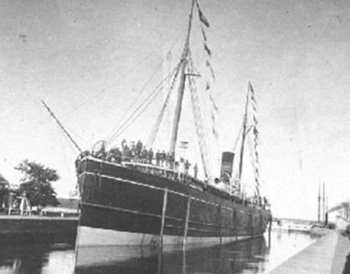
Steam Ship Algoma at dock. Wikipedia
One of a trio of ships ordered by the Canadian Pacific Railway Company, the Steam Ship Algoma was distinguished from its sisters by its short and tragic life, ending in the largest loss of life in all Great Lakes maritime disasters. The 48 who perished in the 1885 wreck underscored the violent power of nature’s fury, aided perhaps by an unusual design element of the three sisters.
The Algoma, along with its sisters SS Athabasca and SS Alberta were built at Scotland’s Aitken & Mansell shipyard. All were 262 feet long, 38 feet wide and 23 feet deep. David Rowan engines provided 1,225 horsepower to a single screw, with this propulsion augmented by two masts for sail power. They were the first steel-hulled passenger-freighters to ply the Great Lakes. However, the length was a problem. To deliver the vessels to the Great Lakes, they would have to pass from Lake Ontario to Lake Erie through Welland Canal, which was shorter than the ships. A shorter freighter would not offer the economy of a larger one. Therefore, all were designed to be cut in half, with bow and stern sections transported by barge through the Saint Lawrence River canal, and then rejoined once they were past the bottleneck.
All went according to plan as the ships were built then launched from Scotland in July 1883. They took only 13 days to cross the Atlantic Ocean, arriving with loads of coal at Montreal, Quebec, where they were disassembled, barged through the canal, then reassembled at Buffalo, N.Y. There, the Algoma was fitted with additional first-class cabins and the first electrical lighting system on a Great Lakes ship. It was relaunched to continue on to its new home at Lake Huron’s Owen Sound, where it was to settle into steady service to Port Arthur, Canadian Pacific’s easternmost rail terminal on Lake Superior’s Thunder Bay.
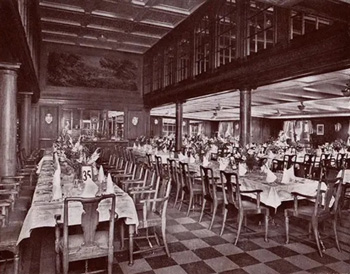
Cabin class dining room on a typical Canadian Pacific Railway passenger-freighter. Freepages.rootsweb.com
Owen Sound was bustling with its largest crowd ever when the Algoma became the first of the trio to arrive on May 13, 1884. More than just the arrival was being celebrated at the new passenger terminal. The day also marked the recent merger of three rail lines – the Ontario and Quebec, Toronto Gray and Bruce and Credit Valley companies into the Canadian Pacific Railroad’s Ontario Division. Standing room only crowds filled Mark’s dock, which was festooned with flags and bunting. Ship bells and whistles sounded as the Algoma pulled up to let the hundreds of Scottish and English emigrants set foot in their new land. The next morning, more than 1,100 passengers – well above its 840 capacity – crowded aboard the ship for its maiden voyage to Port Arthur.
Accommodations aboard all three ships were truly first class. First- and tourist-class passengers were treated to fine meals, and could relax with cocktails in the lounge and dining room, although a few groused about the coffee. Because of a shortage of java beans, an ample proportion of ground burnt peas was added to fortify the strong, dark beverage.
Except for the winter months when freezing halted shipping on the Great Lakes, the ships provided regularly scheduled service on the 411-nautical-mile route between the Lake Huron and Lake Superior ports. The route passed between the lakes through the Soo Locks that bypass the rapids of the Saint Mary River at Sault Saint Marie. Cargo holds moved tons of merchandise, ores, coal, grain and livestock. However passenger service began to dwindle once Canadian Pacific Railroad established an all-rail service around Lake Superior.
Algoma’s final voyage
Between the new rail service and the lateness of the season, the Algoma had its lightest passenger load ever when it left Owen Sound on November 5, 1885. Only seven first-class cabins were booked with families and six additional passengers were in steerage, bringing the roster to 37 passengers. About 134 tons of general merchandise and 297 tons of rail supplies were packed into the hold. A few more passengers boarded as the Algoma passed through Sault Saint Marie on November 6 at the hands of Captain John Steed Moore. At 33 years of age, Moore was a veteran of the Great Lakes. The Sarnia, Canada, native grew up in a family of mariners, and was well familiar with the foibles of the lakes through 18 years of working on this and other ships.
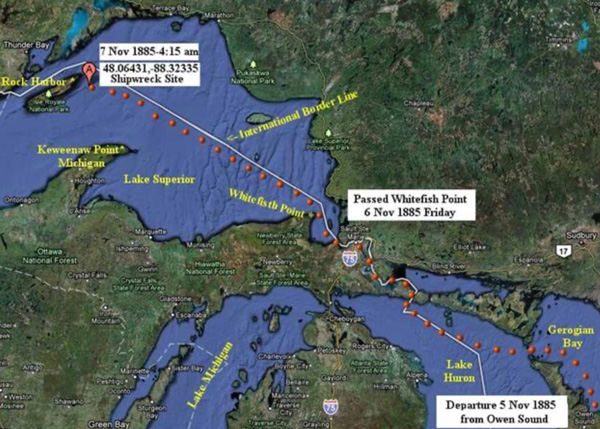
Map shows the course of the Algoma with a pointer on its wreck site. Freepages.rootsweb.com
The Algoma passed Whitefish Point – known as the graveyard of the lakes – at about 1:50 p.m. and entered the Lake Superior with a strong breeze blowing east northeast. Captain Moore took advantage of the wind by raising sails as the Algoma proceeded through moderate seas with occasional rain-filled squalls. The storm gained power steadily as the night wore on. Rain shifted to blasts of snow and sleet as swells grew into monstrous waves, pitching the ship as if it were a tiny cork bobbing in a maelstrom. Some tried to shrug off the tempest by retiring to their cabins, while many stayed up on the decks fighting off seasickness and trying to ease their fears by talking with fellow passengers.
By the wee hours of November 7, Captain Moore had lowered the sails, and sought protection of the leeward side of Isle Royale, a long, narrow spit of land usually marked with Passage Island Lighthouse, which had been closed for the season a month earlier. Inching along the island, with fog horns blaring to provide some sense of location in the near-zero visibility blizzard, the Algoma shuddered with a sickening thud as its stern grounded on Greenstone Point just off Isle Royale. The storm then pushed it forward until a second jolt firmly anchored the stern, while boulders broke through the hull just ahead of the boilers. Water cascaded in, dousing the steam engine’s fire and extinguishing the electrical lights.
Passengers below decks scrambled in the pitch black corridors to make sense of the chaos as the storm lashed the ship. First Mate Joseph Hastings rushed down to the cabins to lead people to what he thought would be the safety of the forward deck. With a mighty crack, the bow was wrested from the stern and began slipping off into the violent frigid waters, sweeping many to their deaths while others panicked and flung themselves into the foam. In less than 20 minutes, the entire forward section drifted off and sank, carrying humans and cargo to the depths.
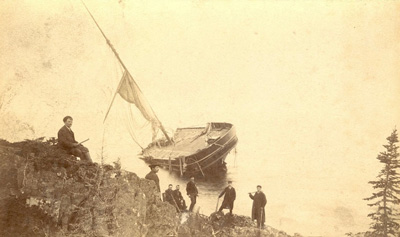
Algoma wreck lies just off Isle Royale National Park. Wikipedia
Though injured, Captain Moore heroically managed to run a lifeline along the stern to which remaining crew and passengers clung as waves and timbers crashed around them. Several tried to swim the short distance to the island, and a few made it while clinging to life preservers. On the following morning, a line was stretched to those on land, and several crew, including Captain Moore lashed themselves to a lifeboat to pull themselves toward the island. As they approached land using a board wrenched from the boat as a paddle, a wave knocked them all out of the boat where they were surprised to find themselves in knee-deep water from which they scrambled on to safety. An hour later, the storm subsided, and local fishermen found the survivors and took them into their homes.
By November 9, word was out to look for the Algoma, by then two days overdue at Port Arthur. Captain Moore advised the Isle Royale fishermen to keep an eye out for her sister ship Athabasca, which had left Owen Sound two days after the Algoma. The ship was intercepted and picked up the survivors to ferry them on to Port Arthur.
The passenger roster was lost in the wreck, so there is some uncertainty about the toll, particularly among those who boarded the ship en route. However, the official tally was 48 lost, including 35 crewmen and 13 passengers. Survivors included 12 crew and two passengers. A Royal Navy commission investigating the disaster censured Captain Moore and Chief Officer Joseph Hastings. Moore’s license was suspended for nine months, reduced to six months due to his previous good record. Hastings’ certificate was suspended for six months.
The Algoma’s sister ships served with less drama, according to records at the Thunder Bay Public Library. The Alberta had a rocky start with four minor accidents in its first year of service, including plowing into the wooden steamer the J.M. Osborne, sinking it with a loss of four lives. It continued working the lakes until it was scrapped at Indiana Harbor in 1947.
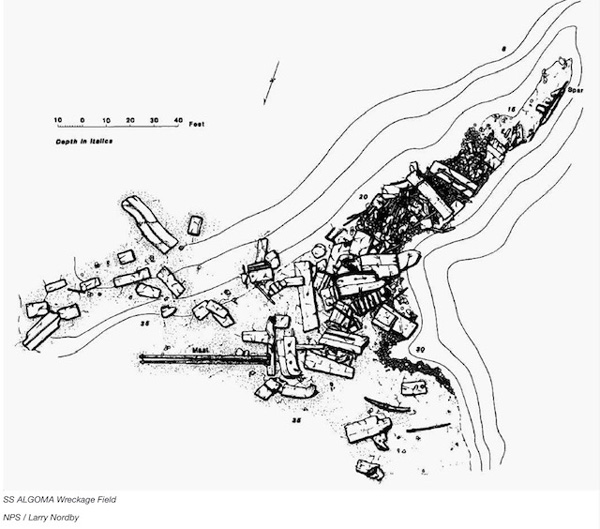
Diagram shows the Algoma wreck site, which can be visited by scuba divers. Wikipedia
The Athabasca served with little notice except for a July 14, 1891, collision on Saint Mary’s River approaching the Soo Locks. The captain of a newly launched ore carrier, the Pontiac, had a reputation of hogging the river channel. The Athabasca captain was reluctant move aside for it, ramming the Pontiac and sending it to the bottom. The Athabasca arrived at the Soo Locks with the Pontiac’s bow stretched across its own. The ship was also scrapped in 1947 at Hamilton, Ontario.
Although most of the Algoma’s cargo was lost in the sinking, its David Rowan engine was salvaged from the stern and installed in the Steam Ship Manitoba. What remains of the stern can be visited by divers at 10 to 40 feet of water in Isle Royale National Park. Divers must first obtain a permit at Rock Harbor, Windigo or Houghton Visitors Center. The permit must be returned after the dive. Bring your own filled tanks for fills are not available on the island. Lake water is cold year-round. The wreck is federally protected, so take only pictures and leave only bubbles.
Author: Bob Sterner
Bob Sterner has covered sport diving and marine conservation with stories and photos as a staffer and freelancer for leading magazines and news organizations. The founding co-publisher and editor of Immersed, the international scuba diving magazine, he has represented the publication and been a presenter at scuba diving trade shows across the US, Canada and Asia.
3 Comments
Submit a Comment
All Rights Reserved © | National Underwater and Marine Agency
All Rights Reserved © | National Underwater and Marine Agency
Web Design by Floyd Dog Design
Web Design by Floyd Dog Design

Very interesting reading. Thanks for posting.
I take issue with the statement, “ending in the largest loss of life in all Great Lakes maritime disasters.” It is not true and easily proven. Even discounting the Eastland disaster, there have been a number of ships that had a larger loss of life, ie. the Lady Elgin, the Erie, and the Alpena, to name a few.
Thank you for bringing these tragedies to our attention. I’ve got some research to do!